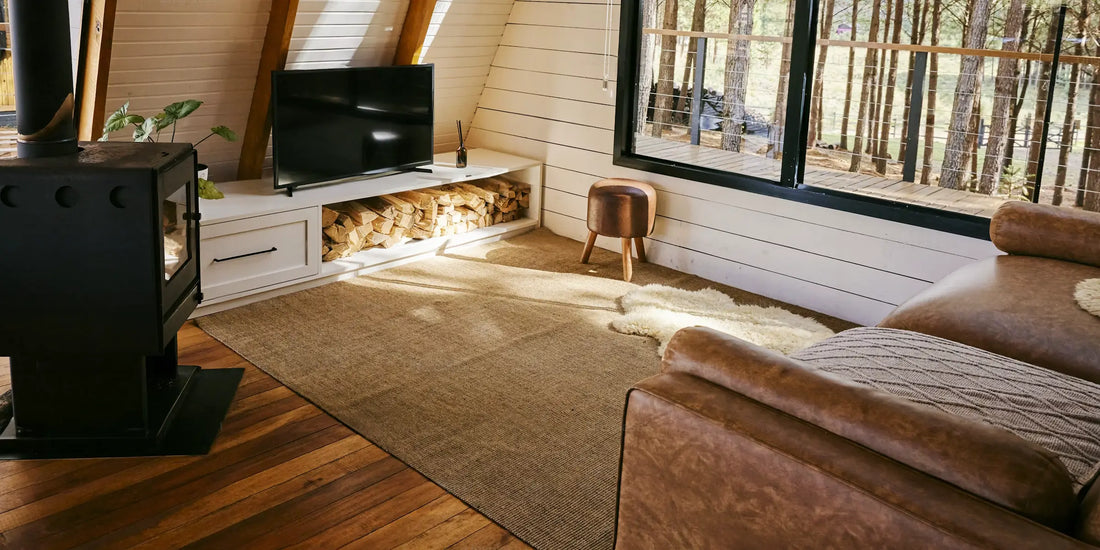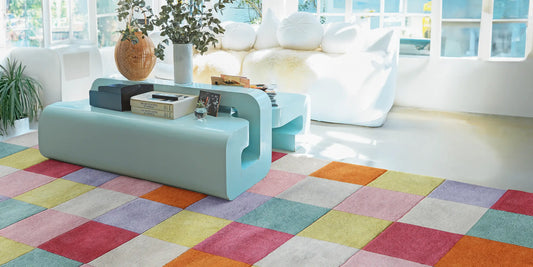How Do Rugs Contribute to a Warmer Home During Winter?

Winter is almost here, and we all want a cozy home to retreat to. But did you know that there's a secret weapon in the battle against cold floors? That's right — rugs! These versatile pieces not only add style to your space but also provide much-needed warmth during the chilly months.
In the world of rug makers, one brand stands out for its commitment to comfort and ethical practices: JUBI. Founded by Cassie and her Grandma Lina, JUBI creates beautiful rugs that are designed to make your feet happy and your home stylish.
But JUBI is more than just another rug company. Their collection goes beyond looks, with each rug telling a story of sustainability and ethical production.
In this article, we'll explore:
- The importance of a warm and cozy home for your physical and mental well-being during winter.
- How rugs can help insulate your space with materials like wool and shaggy designs.
- The science behind thermal conductivity and why some rugs are better at keeping the cold at bay.
- Key factors to consider when choosing a rug for maximum winter warmth — think material, thickness, and size.
- Other ways rugs can enhance your winter comfort, such as reducing noise and providing a soft landing for your feet.
Through their dedication to both sustainability and craftsmanship from around the world, JUBI makes it easy for you to bring warmth into your home while making conscious choices.
Get ready to discover how picking the perfect rug can be an opportunity to create beauty and support ethical practices at the same time.
The Significance of a Warm and Cozy Home in Winter
A warm home during the winter months is not just a matter of comfort, but a significant contributor to our overall well-being. As temperatures drop outside, the warmth of our living spaces becomes an essential refuge that envelops us with a sense of safety and relaxation.
This cozy sanctuary plays a pivotal role in warding off the chill and creating an environment where we can thrive despite the harshness of winter weather.
1. Physical Health Benefits
-
Stable body temperature: A consistently warm environment helps maintain our core body temperature, reducing the strain on our bodies to generate heat.
-
Prevention of illnesses: Warm interiors can decrease the likelihood of suffering from colds, the flu, and other respiratory conditions prevalent in colder climates.
2. Mental Well-being
-
Improved sleep: A comfortably heated bedroom contributes to better sleep quality, which is integral to physical health and mental clarity.
- Stress reduction: A cozy atmosphere provides a psychological comfort that can alleviate stress and anxiety often exacerbated by cold, dreary weather.
By creating a warm home in winter, we nurture both our bodies and minds, fostering an environment conducive to rest and rejuvenation. This underlines the importance of thoughtful home decor choices that contribute to thermal comfort—choices like adding rugs to our floors, which we will delve into next.
1. Insulating Properties: How Rugs Help Keep the Cold at Bay?
Rugs are not just decorative items; they play a crucial role in creating warmth within our homes during the frigid winter months. Their insulating properties are key to maintaining a comfortable indoor climate, and certain types of rugs excel in this respect.
Types of Rugs That Offer Enhanced Insulation
When it comes to choosing rugs with superior insulating properties, material and weave are significant factors.
Here are some prime examples:
- Wool Rugs: Wool is renowned for its insulation capabilities. Its natural fibers not only retain heat but also regulate moisture, which contributes to a consistently warm and dry environment.
-
Shaggy Rugs: With their long, luxurious piles, shaggy rugs trap warm air effectively, acting as thermal barriers between your feet and cold floors.

-
Thick Tufted Rugs: The density of tufted rugs makes them excellent insulators. The thicker the rug, the more heat it retains, ensuring that less warmth escapes into the floor

-
Hand-Knotted Rugs: The intricate craftsmanship of hand-knotted rugs results in a dense fabric that is adept at keeping the chill of the floor at bay.

- Natural Fiber Rugs: Besides wool, other natural fibers like jute and sisal have insulating qualities. They add texture and warmth to any room while being eco-friendly options.

By incorporating these types of rugs into home decor, you can significantly enhance the thermal comfort of living spaces.
The Science Behind Rug Insulation: Understanding Thermal Conductivity
The ability of a rug to insulate a room boils down to thermal conductivity—a measure of how easily heat passes through a material. Materials with low thermal conductivity are better insulators because they slow down the transfer of heat. Here's why specific rug materials are more effective:
- Wool's Crimped Fibers: Wool fibers are naturally crimped, creating tiny air pockets that trap heat. This structure minimizes thermal conductivity, making wool an excellent material for insulation.
- Thickness Equals Resistance: The thicker the rug, the longer it takes for heat to travel through it. This resistance to heat flow contributes to a rug's insulating effectiveness.
- Pile Height Matters: Taller piles in shaggy or tufted rugs create more space for trapping air, which is an excellent insulator.
Understanding these principles helps in making informed decisions when selecting a rug for its warmth-enhancing qualities.
These insights reveal how strategic choices in rug selection can make significant differences in home comfort during winter months. As temperatures drop outside, a well-chosen rug can be a barrier against the cold seeping in from below.
With JUBI's collection showcasing sustainable and ethically-made options, you don't have to compromise on style while seeking out the perfect winter rug.
Rugs play a crucial role in keeping our homes warm during winter. But have you ever wondered how they do it? The answer lies in the science of thermal conductivity.
Thermal conductivity measures how well a material can conduct heat. And when it comes to insulation, we want materials with low thermal conductivity. Here's why:
- Materials with low thermal conductivity are excellent insulators because they slow down the transfer of heat.
-
This means that they can keep spaces warmer for longer periods by preventing heat from escaping.
How Rugs Provide Insulation and Retain Heat?
-
Trapping Warm Air: Rugs have the ability to trap warm air in their fibers, creating a barrier between the cold floor and the room. This trapped air acts as an additional layer of insulation.
-
Density and Thickness: The density and thickness of rug fibers also play a role in their insulating properties. Generally, thicker and denser rugs offer better insulation because they have more space to hold heat.
-
Choosing the Right Material: When it comes to rug insulation, the type of material matters too. Natural fibers like wool have a lower thermal conductivity compared to synthetic materials, making them superior for insulation. Wool fibers also contain tiny pockets of air, which further enhance their ability to retain warmth.
How Rugs Help Prevent Cold Air from Entering?
-
Acting as a Physical Barrier: In addition to retaining heat, insulating rugs also serve as a physical barrier against cold air. They prevent chilly drafts from seeping through floorboards, helping to maintain a more comfortable temperature within the room.
- Reducing Heating Needs: By effectively blocking cold air intrusion, rugs can contribute to energy savings by reducing the need for additional heating.
Understanding these principles allows us to appreciate the scientific foundation behind the comforting embrace of an insulating rug. It's not just about softness underfoot; it's about harnessing the natural properties of materials to foster warmth and energy efficiency in our homes during the colder months.
2. Choosing the Right Rug for Winter Warmth
When temperatures drop, a carefully chosen rug can turn a cold room into a cozy haven. Here are practical tips for selecting rugs that contribute to winter warmth:
Material Matters
- Wool Rugs: Natural fibers like wool are excellent insulators. They hold on to heat, giving you a warm spot for your feet and making the whole room feel snug.
-
Synthetic Fibers: Some synthetic rugs imitate the insulating properties of wool at a more affordable price.
The Thicker, The Better
- High Pile Rugs: Go for high pile or shaggy rugs with longer fibers that trap more heat because of their thickness.
-
Layering Rugs: Think about layering thinner rugs for extra insulation and visual appeal.
Size and Placement
- Large Area Rugs: A bigger rug will cover more floor space, reducing the amount of heat lost through cold floors.
- Strategic Placement: Put rugs in areas where you often walk or sit to make the most of their comfort and warmth.
By considering the material, thickness, and size of your rug, you can effectively make your home cozier during the colder months. Remember, the right rug doesn't just provide warmth but also adds beauty to your decor, making your space welcoming and snug.
3. Beyond Heat Insulation: Other Ways Rugs Contribute to Winter Comfort
Rugs offer a wealth of additional benefits that enhance winter comfort, reaching far beyond their capacity as thermal insulators:
1. Sound Insulation
Rugs act as sound absorbers, dampening the noise of footsteps and echoes in a room. This acoustic benefit is particularly valuable during winter when windows are closed and indoor activities increase. The soft fibers of a rug can significantly reduce the reverberation of sound, promoting a tranquil and serene environment.
2. Improved Foot Comfort
The tactile experience of stepping onto a cold, hard floor can be quite jarring during the frosty months. Rugs provide a cushioned layer that not only retains warmth but also offers a comfortable surface for bare feet.
The plush texture of thicker rugs, such as those crafted by JUBI's artisans, adds an extra level of comfort underfoot, transforming the act of walking across a room into a cozy embrace with each step.
The incorporation of rugs into home decor during colder times does more than just warm up the space physically; it fosters an inviting atmosphere where every sense is catered to, enhancing the overall experience of comfort and warmth in one's sanctuary.
JUBI's Commitment to Sustainable and Ethical Rug Production
At the core of JUBI's values is a strong commitment to producing rugs in a sustainable and ethical manner. The brand sets itself apart by:
1. Sustainability
Every rug created by JUBI reflects their dedication to sustainability. They have adopted a made-to-order model that not only caters to individual customer preferences but also significantly reduces waste. This approach ensures that there is no excess inventory, minimizing the brand's environmental impact.
2. Ethical Practices
JUBI believes in doing business the right way. They work directly with independent artisans and small businesses, providing fair wages and creating opportunities for these individuals and communities to thrive. By purchasing a JUBI rug, you are supporting traditional craftsmanship and contributing to the economic growth of these talented creators.
3. Timeless Craftsmanship
JUBI takes pride in combining modern designs with traditional artistry, resulting in a collection of rugs that are both visually striking and exceptionally well-made. Each piece represents the meticulous craftsmanship that has been passed down through generations, making it a true work of art.
4. Supporting Artisans
When you choose a JUBI rug, you are making a positive impact on the lives of artisans around the world. Your purchase helps preserve their unique cultural practices and ensures that they are fairly compensated for their hard work and skill.
JUBI's values go beyond just aesthetics – they believe in creating beautiful designs while also showing respect for people and the planet.
Conclusion
As temperatures drop, the quest for a warm sanctuary becomes paramount. Rugs serve not just as design elements but as essential winter allies, providing insulation and comfort underfoot. At JUBI, we are committed to enhancing your home’s warmth with aesthetically appealing and ethically-made rugs.
Embrace the colder months by integrating rugs that marry function with ethical craftsmanship. Choose from JUBI's range where each piece is more than a mere accessory; it's a testament to sustainable practices and artisanal heritage. When you choose JUBI, you choose:
- Warmth: An array of rugs designed to offer superior insulation.
- Sustainability: Decor that aligns with eco-friendly values.
- Ethical Production: Support for fair wages and traditional craftsmanship.
Let your winter decor reflect a conscious choice—opt for rugs that encapsulate the warmth of your home and the integrity of its making. JUBI’s collection awaits to elevate your space through designs that resonate with both beauty and responsibility.
Take pride in creating a cozy retreat this winter with choices that resonate beyond aesthetics; choices that contribute to a warmer home and a kinder world.
FAQs (Frequently Asked Questions)
What is the significance of having a warm and cozy home in winter?
Having a warm and cozy living space is crucial for our well-being, especially during the cold winter months. It provides physical and mental benefits, such as improved sleep quality and reduced risk of cold-related illnesses.
What are some types of rugs that offer enhanced insulation?
Specific types of rugs known for their superior insulating properties include wool or shaggy rugs.
How do rugs act as effective insulators in creating warmth?
Rugs can act as effective insulators by trapping heat and preventing cold air from seeping through the floorboards. This is related to the scientific principles of thermal conductivity and how they relate to the insulating abilities of different rug materials.
What are practical tips for choosing the right rug for winter warmth?
When selecting a rug for maximizing warmth in a room, consider factors like material, thickness, and size to ensure it provides the desired level of warmth.
What are some additional benefits of using rugs in creating a cozy atmosphere during winter?
Using rugs in creating a cozy atmosphere during winter also offers additional benefits such as sound insulation and improved foot comfort on cold floors.
How does JUBI prioritize sustainability and ethicality in its rug production processes?
JUBI not only focuses on design and quality but also prioritizes sustainability and ethicality in its rug production processes, highlighting their commitment to sustainable and ethical rug production.









